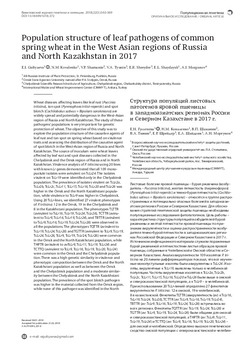Mostrar el registro sencillo del ítem
Population structure of leaf pathogens of common spring wheat in the West Asian regions of Russia and North Kazakhstan in 2017
| Autor: | Gultyaeva, E.I. |
| Autor: | Kovalenko, N.M. |
| Autor: | Shamanin, V. |
| Autor: | Tyunin, V.A. |
| Autor: | Shreyder, E.R. |
| Autor: | Shaydayuk, E.L. |
| Autor: | Morgounov, A.I. |
| Año: | 2018 |
| URI: | https://hdl.handle.net/10883/19538 |
| Resumen: | Wheat diseases affecting leaves like leaf rust (Puccinia triticina), tan spot (Pyrenophora tritici-repentis) and spot blotch (Cochliobolus sativus = Bipolaris sorokiniana) are widely spread and potentially dangerous in the West-Asian region of Russia and North Kazakhstan. The study of these pathogens' populations is very important for genetic protection of wheat. The objective of this study was to explore the population structure of the causative agents of leaf rust and tan spot on spring wheat based on virulence traits and assessing the distribution of the causative agent of spot blotch in the West-Asian region of Russia and North Kazakhstan. The source of inoculum were wheat leaves affected by leaf rust and spot diseases collected in the Chelyabinsk and the Omsk region of Russia and in North Kazakhstan. Virulence analysis of P. triticina using 20 lines with known Lr genes demonstrated that all 109 monopustule isolates were avirulent on TcLr24. The isolates virulent on TcLr19 were identified only in the Chelyabinsk population. The prevalence of isolates virulent on TcLr2a, TcLr2b, TcLr2c, TcLr11, TcLr15, TcLr16, TcLr20 and TcLr26 was higher in the Omsk and the North Kazakhstani population, while virulence to TcLr9 was higher in Chelyabinsk. Using 20 TcLr-lines, we identified 27 virulent phenotypes of P. triticina: 12 in the Omsk, 19 in the Chelyabinsk and 8 in the Kazakhstani population. The phenotypes TLTTR (avirulent to TcLr16, TcLr19, TcLr24, TcLr26), TCTTR (avirulent to TcLr9, TcLr16, TcLr19, TcLr24), and TBTTR (avirulent to TcLr9, TcLr16, TcLr19, TcLr24, TcLr26) were observed in all the populations. The phenotypes TQTTR (avirulent to TcLr19, TcLr24, TcLr26) and TGTTR (avirulent to TcLr9, TcLr19, TcLr24, TcLr26, TcLr9, TcLr19, TcLr24, TcLr26) were common in the Omsk and the North Kazakhstani population, while THPTR (avirulent to avTcLr9, TcLr11, TcLr19, TcLr24) and TCTTQ (avirulent to TcLr9, TcLr16, TcLr19, TcLr20, TcLr24) were common in the Omsk and the Chelyabinsk population. There was a high genetic similarity in virulence and phenotypic composition between the Omsk and the North Kazakhstani population as well as between the Omsk and the Chelyabinsk population and a moderate similarity between the Chelyabinsk and the North Kazakhstani population. The prevalence of the spot blotch pathogen was higher in the material collected from the Omsk region, while none of this pathogen was identified in the North Kazakhstani material. The isolates of tan spot were identified in all the regions. Five races of P. tritici-repentis were identified among Chelyabinsk isolates based on the toxins produced by the following pathogens: race 1 (PtrToxA PtrToxC); race 2 (PtrToxA); race 7 (PtrToxA, PtrToxB), race 8 (PtrToxA, PtrToxB, PtrToxC), and race 4 (does not produce toxins). Three races were identified in the Omsk region (1 - 3) and four, in North Kazakhstan (1 - 4). A total of 26 P. tritici-repentis phenotypes were identified by virulence analysis using 11 differential lines: two were present in all the populations; two. in Chelyabinsk and North Kazakhstan; one, in Omsk and Chelyabinsk; and all the others were original. A high degree of similarity between the obligate pathogen P. triticina and the saprophytic pathogen P. tritici-repentis in the West-Asian region of Russia and in North Kazakhstan demonstrates that this is one epidemiological region across this wheat production area. The presence of common phenotypes suggests there is a the possibility of gene exchange between the populations and this shall be considered while releasing genetically protected wheat varieties. |
| Formato: | |
| Lenguaje: | English |
| Lenguaje: | Russian |
| Editor: | Institute of Cytology and Genetics of Siberian Branch of the Russian Academy of Sciences |
| Copyright: | CIMMYT manages Intellectual Assets as International Public Goods. The user is free to download, print, store and share this work. In case you want to translate or create any other derivative work and share or distribute such translation/derivative work, please contact CIMMYT-Knowledge-Center@cgiar.org indicating the work you want to use and the kind of use you intend; CIMMYT will contact you with the suitable license for that purpose. |
| Tipo: | Article |
| Lugar de publicación: | Novosibirsk, Russia : |
| Páginas: | 363-369 |
| Número: | 3 |
| Volumen: | 22 |
| DOI: | 10.18699/VJ18.372 |
| Palabras Claves: | Leaf Rust |
| Palabras Claves: | Tan Spot |
| Palabras Claves: | Spot Blotch |
| Palabras Claves: | Populations |
| Palabras Claves: | Lr-Genes |
| País: | WEAST ASIA |
| País: | RUSSIA |
| País: | NORTH KAZAKHSTAN |
| País: | CHELYABINSK |
| País: | OMSK |
| Agrovoc: | RUSTS |
| Agrovoc: | LEAF BLOTCH |
| Agrovoc: | SPRING WHEAT |
| Agrovoc: | VIRULENCE |
| Agrovoc: | PLANT POPULATION |
| Agrovoc: | GENES |
| Revista: | Vavilov Journal of Genetics and Breeding |
Ficheros en el ítem
Este ítem aparece en la(s) siguiente(s) colección(ones)
-
Wheat
Wheat - breeding, phytopathology, physiology, quality, biotech

